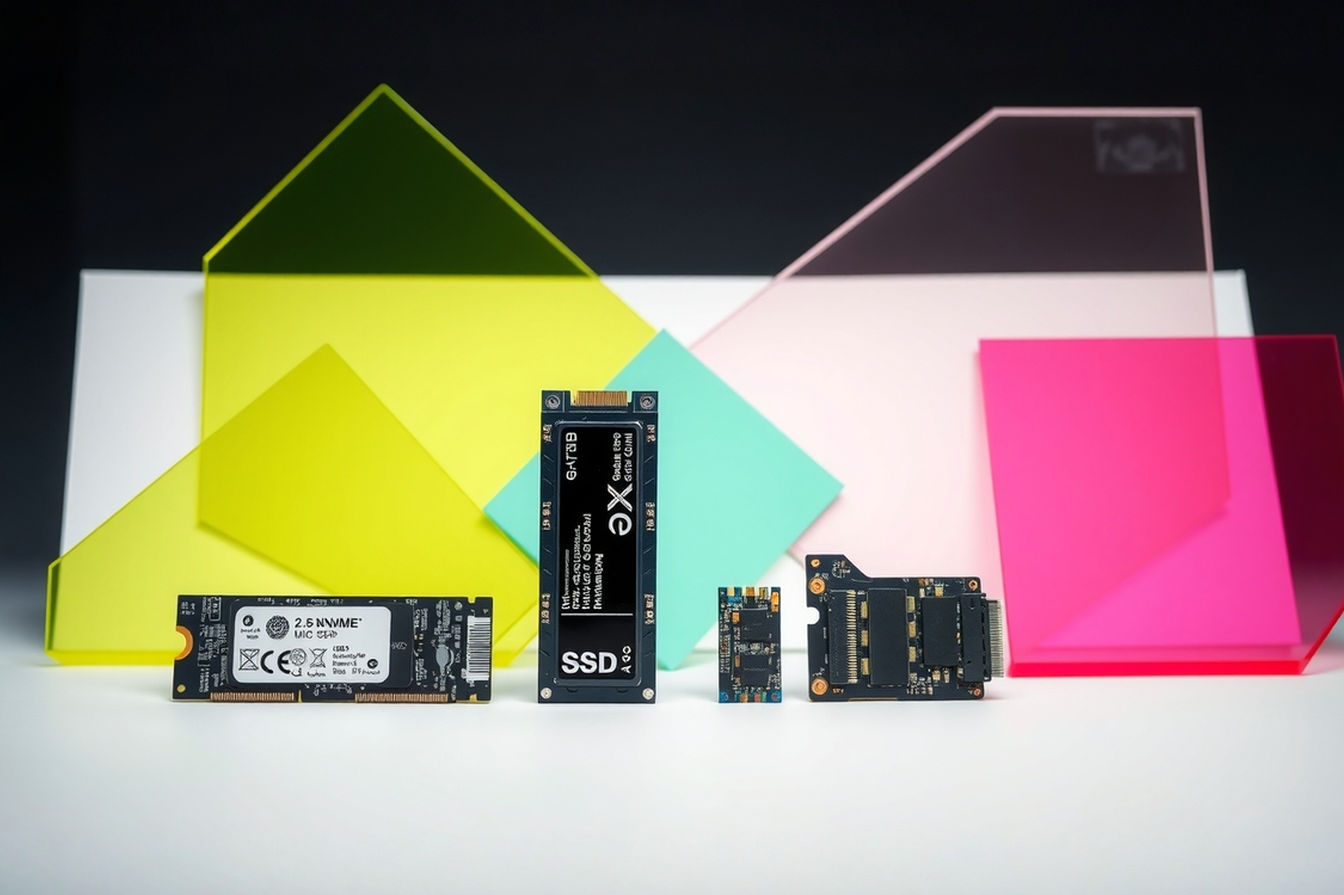This post may contain affiliate links. If you make a purchase through these links, we may earn a commission at no additional cost to you.
When you’re looking to boost a laptop’s speed or expand its storage, understanding the heart of a traditional hard drive is key. Hard Disk Drives (HDDs) have been around for decades, storing our digital lives on spinning magnetic platters. While Solid State Drives (SSDs) are now common, HDDs still offer massive capacity for less money, making them relevant for many users. But not all HDDs are the same. They come in different sizes, or “form factors,” with the most common being 2.5-inch and 3.5-inch.
You might wonder, “Which one is better for my laptop?” This is a great question, though it has a bit of a twist. While 2.5-inch drives are the standard internal drive size for laptops, 3.5-inch drives are typically used in desktop computers and larger external enclosures. You won’t usually find a 3.5-inch drive inside a standard laptop because it simply doesn’t fit. However, comparing their performance characteristics is still valuable, especially when considering external storage options or understanding the technical trade-offs involved in drive design.
In this guide, we’ll dive deep into the technical differences between these two HDD sizes, explain how those differences impact performance, and help you understand which drive type might be best for your needs, particularly in scenarios relevant to laptop users, such as external storage or potential internal replacements with 2.5-inch drives. Let’s break down the spinning world of hard drives.
Understanding the Core of Hard Drive Performance
Before we compare the two sizes, let’s quickly cover how a traditional hard drive works and what factors influence its speed. Think of an HDD like a record player, but storing computer data instead of music. Inside the drive, there are one or more rigid, circular platters coated with a magnetic material. These platters spin at high speeds. A read/write head, attached to an arm that moves across the platter surface, reads data by detecting the magnetic patterns and writes data by changing those patterns.
Several key technical specifications determine how quickly an HDD can access and transfer data:
Revolutions Per Minute (RPM)
This is perhaps the most commonly cited speed metric for hard drives. Revolutions Per Minute (RPM) measures how fast the platters inside the drive spin. The faster the platters spin, the quicker the read/write head can access any given piece of data on the platter’s surface.
Common RPM speeds for HDDs include 5,400 RPM, 7,200 RPM, 10,000 RPM, and even 15,000 RPM (though these higher speeds are usually found in enterprise-grade drives). A drive spinning at 7,200 RPM is generally faster than one spinning at 5,400 RPM, assuming other factors are equal. This is because the data passes under the head more frequently.
Data Transfer Rate
Also known as throughput, the data transfer rate measures how much data the drive can read from or write to the platters sequentially in a given amount of time. This is typically measured in megabytes per second (MB/s).
Several factors influence the data transfer rate:
- RPM: Faster spinning platters mean data bits pass under the head more quickly.
- Areal Density: This refers to how much data is packed onto the surface of the platter. Higher density platters allow the head to read more data in a single rotation, improving the transfer rate. Drive manufacturers constantly work to increase areal density using technologies like Perpendicular Magnetic Recording (PMR) and Shingled Magnetic Recording (SMR).
- Location of Data: Data on the outer tracks of a platter passes under the head faster than data on the inner tracks because the circumference is larger. This means sequential transfer speeds can be higher when reading or writing data towards the beginning (outer edges) of the drive.
Access Time and Latency
While data transfer rate measures sequential speed, access time (also called random access time) measures how quickly the drive can locate a specific piece of data anywhere on the disk. This is crucial for tasks involving many small, random reads and writes, like opening applications, booting the operating system, or multitasking.
Access time is composed of two main parts:
- Seek Time: The time it takes for the read/write head to move from its current position to the track where the data is located. This is a physical movement, and it’s often the slowest part of the process.
- Rotational Latency: The time it takes for the desired sector on the platter to rotate around and come under the read/write head after the head has reached the correct track. This depends directly on the drive’s RPM.
Latency is often used interchangeably with rotational latency or refers to the overall delay between requesting data and receiving it. Lower access times and latency result in a more responsive system.
Cache Size
Hard drives include a small amount of high-speed memory called a cache (or buffer). The drive uses this cache to temporarily store data that is frequently accessed or data that is about to be written to the platters. A larger cache can help improve performance, especially for read/write operations that are not purely sequential, by reducing the need to wait for the slower mechanical parts. Common cache sizes range from 8MB to 256MB or more.
Understanding these metrics—RPM, data transfer rate, access time, and cache—is essential for appreciating the performance differences between hard drives, regardless of their size.
The Physical Difference: 2.5-inch vs. 3.5-inch
The most obvious distinction between these two types of HDDs is their physical size. The “inch” measurement refers roughly to the diameter of the internal platters, though the actual dimensions of the drive enclosure are standardized.
- 3.5-inch HDDs: These drives are larger, typically measuring around 4 inches wide, 5.8 inches long, and 1 inch thick. Their size allows them to accommodate more platters (sometimes up to 8 or 10 or even more in high-capacity models) and larger diameter platters compared to their smaller counterparts. They require a dedicated power connection from the computer’s power supply unit (PSU) and a data connection (usually SATA). They are the standard internal drive size for desktop computers and are commonly used in Network Attached Storage (NAS) devices and external desktop hard drives that require an external power adapter.
- 2.5-inch HDDs: These drives are significantly smaller and slimmer, typically measuring around 2.8 inches wide, 4 inches long, and either 9.5mm or 7mm thick. Their compact size means they can fit fewer and smaller platters. They draw power directly through the data connection (like SATA or USB), meaning they don’t usually need a separate power cable when connected internally or via a standard external enclosure. They are the standard internal drive size for laptops and are also used in smaller, portable external hard drives that are bus-powered (drawing power from the USB port).
This fundamental size difference has cascading effects on their design, capabilities, and ultimately, their performance characteristics.
Performance Metrics: A Direct Comparison
Now, let’s compare how the physical differences between 2.5-inch and 3.5-inch HDDs translate into performance differences across the metrics we discussed.
RPM Capabilities
Historically, 3.5-inch drives have had an advantage in terms of available RPM speeds. Because they are larger and consume more power, they can more easily accommodate faster, more powerful spindle motors needed to spin larger platters at higher speeds.
- 3.5-inch: Commonly available at 7,200 RPM. Higher-performance and enterprise drives are available at 10,000 RPM and 15,000 RPM.
- 2.5-inch: Most consumer 2.5-inch drives operate at 5,400 RPM, prioritizing lower power consumption and heat output suitable for laptops. While 7,200 RPM 2.5-inch drives exist, they are less common, can generate more heat, and might consume more power, potentially impacting laptop battery life. Drives faster than 7,200 RPM are rare in the 2.5-inch form factor, primarily found in specialized enterprise-class drives.
This difference in typical RPM ranges means that, on average, 3.5-inch drives tend to have faster platter rotation speeds than 2.5-inch drives, giving them a potential edge in both sequential transfer rates and rotational latency.
Data Transfer Rates
The sequential data transfer rate is influenced by both RPM and areal density. While areal density has improved across both form factors over time, the ability to spin platters faster gives 3.5-inch drives an advantage in raw sequential speed, especially on their outer tracks.
- 3.5-inch: Typical 7,200 RPM drives can achieve sequential read/write speeds ranging from 100 MB/s to over 200 MB/s, depending on the specific model, platter density, and location of data on the platter. High-end 10,000+ RPM drives can be even faster.
- 2.5-inch: Most 5,400 RPM drives typically offer sequential speeds ranging from 80 MB/s to 120 MB/s. 7,200 RPM 2.5-inch drives can reach speeds closer to 100-150 MB/s.
For large file transfers (like copying movies or backup images), a 3.5-inch drive, particularly a 7,200 RPM model, will generally complete the task faster than a typical 5,400 RPM 2.5-inch drive.
Access Time and Latency
Random access performance is heavily impacted by seek time and rotational latency. While rotational latency is directly tied to RPM (faster RPM means lower latency), seek time is related to how quickly the read/write arm can move across the platters.
- 3.5-inch: With potentially higher RPMs, 3.5-inch drives can have lower rotational latency. However, the read/write arm has a longer distance to travel across the larger diameter platters, which can increase seek time.
- 2.5-inch: While often having lower RPMs (meaning higher rotational latency), the read/write arm has a shorter distance to travel across the smaller diameter platters, potentially leading to faster seek times.
In practice, the combination of these factors often results in 3.5-inch drives, especially those with higher RPMs, having a slight edge in overall random access performance compared to typical 2.5-inch drives. This means tasks involving lots of small, random data requests might feel a bit snappier on a faster 3.5-inch drive. However, the difference is usually less pronounced than the difference in sequential transfer rates.
Cache Size
3.5-inch drives often come with larger cache sizes compared to 2.5-inch drives, especially when comparing drives at similar price points or capacity tiers.
- 3.5-inch: Commonly found with 64MB, 128MB, or 256MB cache.
- 2.5-inch: Often have 8MB, 16MB, 32MB, or 128MB cache.
A larger cache can buffer more data, potentially smoothing out performance during mixed read/write operations and reducing the impact of mechanical delays. This is another factor that can contribute to the generally higher performance potential of 3.5-inch drives.
Why Laptops Exclusively Use 2.5-inch Drives Internally
Given that 3.5-inch drives generally offer higher performance potential and larger capacities (we’ll touch on capacity next), you might wonder why laptops don’t use them. The reasons are purely practical and related to the fundamental design goals of a portable computer:
- Size and Weight: Laptops are designed to be compact and lightweight. A 3.5-inch drive is significantly larger and heavier than a 2.5-inch drive. Including one would make laptops much bulkier and heavier, defeating the purpose of portability.
- Power Consumption: 3.5-inch drives require more power to spin their larger platters and move their heavier read/write arms. This power draw is typically supplied by a desktop power supply unit. Laptops rely on limited battery power or smaller external power adapters. Using a 3.5-inch drive would drastically reduce battery life and require a larger, less portable power adapter. 2.5-inch drives are designed to be more power-efficient, often drawing enough power directly from the SATA data connection or a USB port.
- Shock Resistance: Laptops are portable and are more likely to be moved, bumped, or even dropped while in operation. 2.5-inch drives are generally designed with better shock resistance than 3.5-inch drives. Their smaller, lighter components are less susceptible to damage from sudden movements or impacts. 3.5-inch drives are designed for stationary use in desktops or servers and are more vulnerable to shock damage.
Because of these critical design considerations, the 2.5-inch form factor became the standard for internal laptop storage.
Performance in External Drive Use Cases
While you won’t put a 3.5-inch drive inside your laptop, you might connect one externally. This is where the performance comparison becomes directly relevant for laptop users. External hard drives come in both 2.5-inch and 3.5-inch varieties.
- 2.5-inch External Drives: These are typically bus-powered, meaning they draw all the power they need from the USB connection to your laptop. They are highly portable, compact, and don’t require an external power brick. Their performance characteristics mirror those of internal 2.5-inch drives, usually offering 5,400 RPM speeds and sequential transfer rates up to around 120 MB/s. They are great for portable backups, carrying files between computers, or expanding storage for less demanding tasks.
- 3.5-inch External Drives: These drives require an external power adapter because the USB port on your laptop cannot provide enough power for a 3.5-inch drive. They are larger and less portable than 2.5-inch external drives. However, they often contain 7,200 RPM drives, offering higher sequential transfer speeds (potentially 150-200+ MB/s) and generally better random access performance than 2.5-inch drives. They also offer significantly higher storage capacities. These are ideal for large-scale backups, storing large media libraries, or as a secondary storage drive for a desktop replacement laptop that stays in one place.
When used as external drives connected to a laptop, the performance differences between 2.5-inch and 3.5-inch HDDs become noticeable, particularly for tasks involving large file transfers. A 3.5-inch external drive will typically be faster for moving large amounts of data.
Beyond HDDs: The Solid State Drive (SSD) Factor
It’s impossible to discuss modern storage performance without mentioning Solid State Drives (SSDs). SSDs store data on flash memory chips rather than spinning platters. This fundamental difference gives them enormous performance advantages over traditional HDDs, regardless of size.
- Speed: SSDs have no moving parts, resulting in near-instantaneous access times (measured in microseconds, not milliseconds). Their sequential read/write speeds are also vastly higher than HDDs, ranging from 300-550 MB/s for SATA SSDs and reaching into the thousands of MB/s for NVMe SSDs.
- Responsiveness: The low latency and high speeds of SSDs dramatically improve system responsiveness. Boot times are seconds instead of minutes, applications launch instantly, and multitasking is much smoother.
- Durability: With no moving parts, SSDs are far more resistant to shock and vibration than HDDs.
- Power Consumption: SSDs generally consume less power than HDDs, contributing to better battery life in laptops.
- Form Factors: SSDs come in various form factors, including the 2.5-inch size (compatible with laptop HDD bays), M.2 (a small stick-like form factor common in modern laptops), and mSATA.
For the vast majority of internal laptop storage needs today, an SSD provides a performance upgrade that dwarfs the difference between a 5,400 RPM and a 7,200 RPM HDD. If your laptop still uses an HDD, upgrading to an SSD is the single most impactful performance improvement you can make in terms of storage speed.
Comparing SSDs to HDDs (both 2.5″ and 3.5″ external):
- Internal Laptop Storage: SSDs offer vastly superior performance compared to 2.5-inch HDDs.
- External Storage: While high-speed external SSDs exist, 3.5-inch external HDDs still offer the best cost-per-gigabyte for very large capacities, albeit with much lower performance than any SSD. 2.5-inch external HDDs are the most portable but also the slowest option for large storage.
Real-World Impact on Laptop Performance
How does storage performance actually affect how you use your laptop? While the CPU and RAM handle processing, the speed of your storage drive dictates how quickly data can be loaded into and saved from memory. This impacts almost everything you do.
- Boot Times: The time it takes for your operating system to load when you turn on your laptop is heavily dependent on storage speed. An SSD boots in seconds; an HDD takes much longer.
- Application Loading: Programs load much faster from a speedy drive. Large applications or games can take a significant time to open on a slow HDD.
- File Transfers: Copying or moving large files between locations on the same drive or to/from an external drive is directly limited by the drive’s sequential transfer rate.
- Multitasking: When you have many applications open or are working with large files, the operating system constantly reads and writes small pieces of data. A drive with low access time and latency handles these random operations much more efficiently, making multitasking feel smoother.
- Gaming: Game loading times and level transitions are often bottlenecked by storage speed. Open-world games that stream assets from storage benefit significantly from faster drives.
- Media Editing: Working with large video or image files requires constant reading and writing. Faster storage, especially with good random access performance, makes editing much more fluid.
For internal laptop performance, the jump from an HDD to an SSD is transformative. When considering external drives, the difference between a 2.5-inch and a 3.5-inch HDD will be most noticeable during large file transfers.
Choosing the Right Drive for Your Needs
Deciding between drive types for use with your laptop depends entirely on your specific needs and budget.
- For Internal Laptop Storage: The clear choice for performance is an SSD. If your laptop currently has a 2.5-inch HDD, upgrading to a 2.5-inch SATA SSD is a highly recommended performance boost. If your laptop has an M.2 slot, an NVMe SSD will offer even greater speed. A 2.5-inch HDD is only advisable for internal storage if budget is extremely tight and you only need basic functionality, but be prepared for slow performance.
- For Portable External Storage: A 2.5-inch external HDD is the go-to option. They are compact, lightweight, and bus-powered, making them easy to carry and use anywhere. They offer good capacity for their size and are suitable for backups and general file storage on the go. Performance is adequate for most portable tasks but slower than 3.5-inch external drives for large transfers.
- For High-Capacity External Storage: A 3.5-inch external HDD is usually the most cost-effective solution for storing very large amounts of data (multiple terabytes). They offer higher performance than 2.5-inch HDDs, making them better for large backups, media libraries, or as a stationary storage hub. Remember they require external power and are less portable.
- For High-Performance External Storage: If you need speed and external storage, consider an external SSD. These are more expensive per gigabyte than HDDs but offer significantly faster transfer speeds, especially with NVMe-based enclosures and a fast USB port (like USB 3.1 Gen 2 or Thunderbolt).
Conclusion: Size Matters, But Not Always How You Think
In the world of hard drives and laptop performance, size does matter, but not in a way that lets you put a bigger 3.5-inch drive inside your portable computer. Laptops are designed around the smaller, more power-efficient, and more shock-resistant 2.5-inch form factor for internal storage.
Technically, 3.5-inch HDDs generally possess the potential for higher performance due to their ability to accommodate faster RPMs, more platters, and larger caches. This performance advantage is most evident in sequential data transfer rates and can be relevant when comparing 2.5-inch and 3.5-inch drives used as external storage devices.
However, for internal laptop speed, the conversation has largely shifted to Solid State Drives. An SSD offers a performance leap over any traditional HDD, making it the primary consideration for anyone looking to significantly improve their laptop’s responsiveness.
Ultimately, the choice between 2.5-inch and 3.5-inch drives for use with a laptop comes down to balancing portability, capacity needs, performance requirements, and budget, particularly in the realm of external storage solutions. While a 3.5-inch drive might offer better raw HDD performance, its size and power needs confine it to desktop or stationary external use, leaving the 2.5-inch drive as the necessary internal component for laptops, increasingly being replaced by the speed and efficiency of SSDs.






